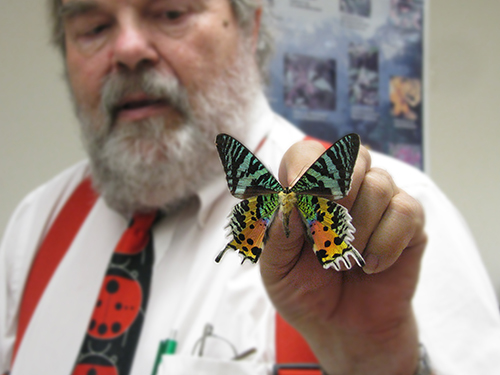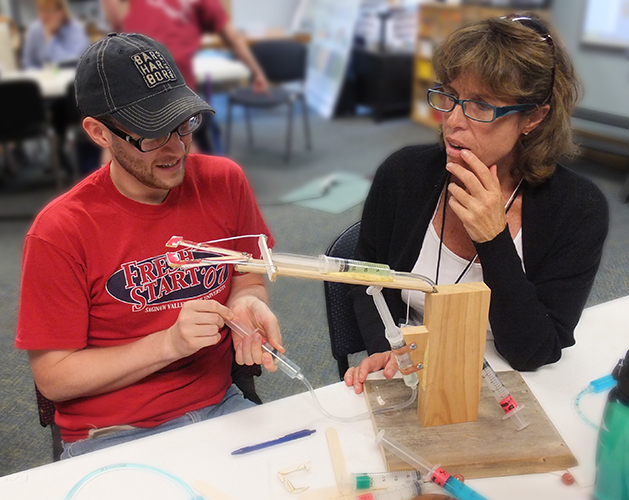Bugs, Biomimicry, and Biodiversity
Two weeks ago, the Smithsonian museums and research facilities were filled with the sights and sounds of adults mimicking insect mating calls, hunting for organisms in brackish water, and allowing African Giant Millipedes to scurry across their willing hands. These adults were participants in the Smithsonian Science Education Academies for Teachers (SSEATS), week-long events focusing on the professional development of science educators. Emphasis is placed on inquiry-based teaching to facilitate effective learning in the sciences. Throughout the week, 20 teachers from all across the country gained a behind-the-scenes look at exhibits within the Smithsonian, participated in hands-on presentations with various scientists, and hiked through the historic Java Trail--land which has been used by Native Americans, colonists, and dairy farmers--all the while discovering creative ways to incorporate the overall theme of biodiversity into their classrooms.
Biodiversity refers to the variety of different species within a region, and while the week included a look at creatures local to Washington, DC, the teachers were also given creative ideas and resources for completing similar tasks within their own cities. Entomologists Nate Erwin, who was with the Smithsonian for 20 years and is currently a freelance biologist, and Gary Hevel, who has been with the Institution for 45 years, spent the day sharing their love of bugs. The participants were given a look into Gary's 25-drawer project, a collection of over 4,000 different species obtained from his backyard over a period of four years. His collection included a golden bug hypothesized to be the star of an Edgar Allen Poe short story, a Sunset moth considered by most to be the prettiest of all the butterflies, and the largest beetle in the Eastern USA--aptly named the Hercules beetle. He concluded his tour by encouraging the group and the public to go out, collect, record, and illustrate. "There's so many darn things out there!"

Entomologist, Gary Hevel, displaying the beauty of the Sunset Moth.
Hands-on activities were especially popular with the participating educators. In alignment with the inquiry-based teaching method, Nate began the next session by asking the group to speculate why insects stridulate--stridulation refers to the sounds made when insects rub parts of their body together. The scientists led a discussion with the group and then explored the concept further by involving the teachers in a mating call activity: in pairs, the participants worked together to come up with a simple rhythm using percussive instruments that would represent their mating call. Half the group was blindfolded, and as the remaining 10 teachers began their instrumental stridulation, the unseeing partner was given the task of attempting to locate their specific pattern using hearing alone. The once abstract concept of stridulation became tangible before the teachers' eyes--or rather, ears. By placing themselves in the insects' shoes, they could understand clearly how the loudest call would be heard above the rest and would easily be the one chosen by a female searching for a mate, assuming it followed the proper pattern.
The next day, the teachers were introduced to the Smithsonian Environmental Research Center (SERC), which encompasses 2, 650 acres of coastal ecosystems--from farmlands and forests to wetlands and the nation's largest estuary, the Chesapeake Bay. The scientists had an abundance of information and activities prepared for the teachers, which they could adapt for their own classrooms. The excursion began on the docks, fishing for--and observing the lifecycle of--the blue crab, a well-known arthropod resident of the Bay. Not only were the teachers shown how to differentiate between the genders, but they also learned how the crabs eat, molt, and how researchers keep tabs on their locations using tags and a reward system.
However, it was when Karen McDonald (a current SSEC curriculum developer who'd previously worked as education outreach coordinator at SERC) introduced the topic of biomimicry that the teachers truly understood the real world application of these lessons. Starting by showing a powerful TED Talk, Karen explained how Biomimicry is everywhere. From the invention of Velcro to the streamlining of speed trains, "biomimicry takes design advice from the genius of nature," Karen explained. Passing around building supplies, tubing, liquid, and laboratory syringes, she then challenged the group to become engineers and create a hydraulic claw system, much like the hydraulics the blue crab uses to move. The group was able to take the day's activities and see them come full circle in a thought-provoking way.

Teachers using biomimicry to create a hydraulic claw system like that of the blue crab.
Observing the excitement of the teachers as they grew increasingly inspired by the week's events, I was reminded of my past instructors, and how their enthusiasm for science and dynamic teaching methods--without a doubt--influenced my own scientific path. "I want my kids to think like scientists," Michigan teacher Mary Jo Griffin said with passion. "If you can tell them interesting things, they'll get it!"
Missed this years Biodiversity Academy? Stay tuned for how you can sign up for next years!
